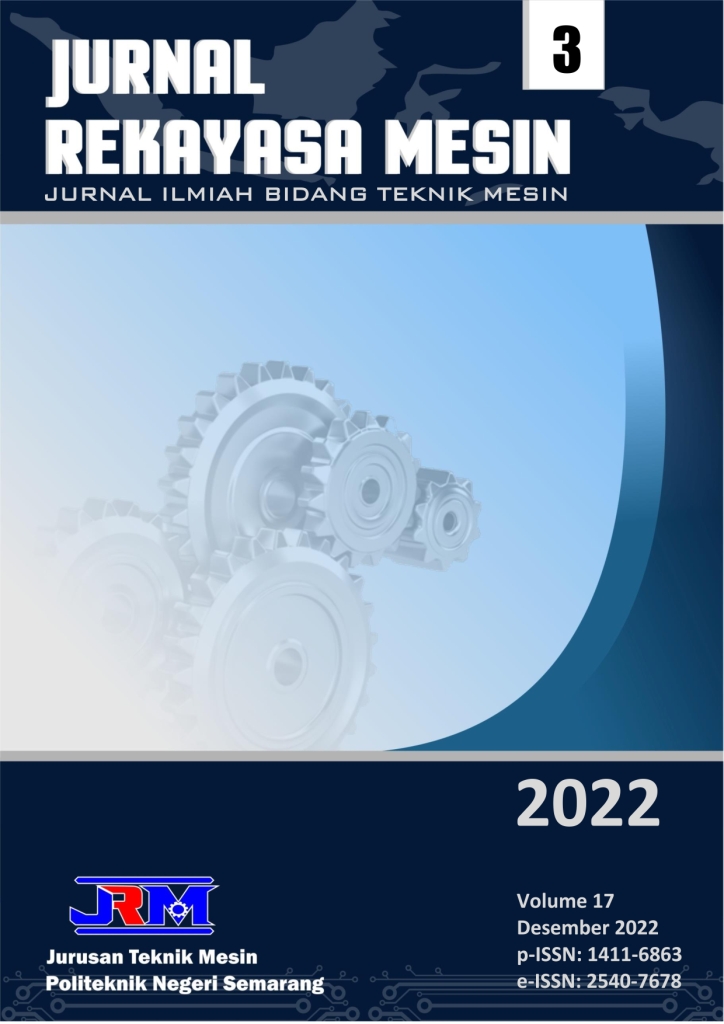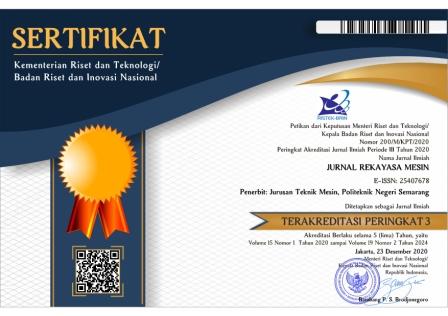Implementation of the Airfoil parameterization PARSEC Method in Python
DOI:
https://doi.org/10.32497/jrm.v17i3.4000Keywords:
Airfoil, NACA, PARSEC, PythonAbstract
Airfoil telah mengalami banyak perkembangan dan optimalisasi melalui berbagai cara. Terdapat berbagai teknik yang dapat digunakan untuk memodifikasi bentuk arifoil standar yang ada saat ini. Metode PARSEC merupakan salah satu teknik parameterisasi yang paling banyak digunakan untuk memodifikasi bentuk airfoil. Paper ini menyediakan penjelasan yang komprehensif.mengenai implementasi metode PARSEC pada bahasa pemrograman python. Studi ini menggunakan Airfoil standar jenis NACA0012 sebagai referensi untuk mengevaluasi metode PARSEC. Airfoil NACA0012 yang dihasilkan dari metode PARSEC kemudian di komparasikan dengan airfoil asli dari NACA0012. Diperoleh bahwa metode PARSEC dapat menghasilkan bentuk arifoil NACA0012 sangat identik dengan airofil NACA0012 yang asli. Pada rentang sudut serang tertentu, nilai CL dan CD dari airfoil yang dihasilkan dari metode PARSEC memiliki nilai CL dan CD yang hampir sama dengan nilai CL dan CD dari airfoil NACA0012 yang asli. Kedua airfoil, NACA0012 yang asli atapun yang dihasilkan dari metode PARSEC memiliki sudut serang optimum yang sama, yaitu 8 °. Nilai CL/CD maksimum dari NACA0012 yang asli dengan NACA0012 yang dihasilkan dari metode PARSEC secara berturut-turut adalah 84.92 dan 84.28. Diharapkan bahwa studi ini dapat menjadi petunjuk praktis bagi peneliti dan praktisi dalam menggunakan metode PARSEC untuk berbagai kebutuhan.
References
M. A. Andira and C. A. Putra, “Comparative Study of Nature-InspiredOptimization Algorithms for Aerodynamics Shape Problem of Subsonic Airfoil,” 2016.
H. M. Lee and O. J. Kwon, “Performance improvement of horizontal axis wind turbines by aerodynamic shape optimization including aeroealstic deformation,” Renew. Energy, vol. 147, pp. 2128”“2140, 2020.
L. Wang et al., “A deep learning-based optimization framework of two-dimensional hydrofoils for tidal turbine rotor design,” Energy, vol. 253, p. 124130, 2022.
D. A. I. Jinzhao, L. I. Haoran, Y. ZHANG, and C. Haixin, “Optimization of multi-element airfoil settings considering ice accretion effect,” Chinese J. Aeronaut., 2022.
W. Wang, B. Li, Y. Tan, B. Li, and Y. Shuai, “Multi-objective optimal design of NACA airfoil fin PCHE recuperator for micro-gas turbine systems,” Appl. Therm. Eng., vol. 204, p. 117864, 2022.
S. Sanaye and A. Hassanzadeh, “Multi-objective optimization of airfoil shape for efficiency improvement and noise reduction in small wind turbines,” J. Renew. Sustain. Energy, vol. 6, no. 5, p. 53105, 2014.
F. Grasso, “Usage of numerical optimization in wind turbine airfoil design,” J. Aircr., vol. 48, no. 1, pp. 248”“255, 2011.
C. Çelik, D. B. Danışman, S. Khan, and P. Kaklis, “A reduced order data-driven method for resistance prediction and shape optimization of hull vane,” Ocean Eng., vol. 235, p. 109406, 2021.
D. A. Masters, N. J. Taylor, T. C. S. Rendall, C. B. Allen, and D. J. Poole, “Geometric comparison of aerofoil shape parameterization methods,” AIAA J., vol. 55, no. 5, pp. 1575”“1589, 2017.
A. Jameson, “Aerodynamic design via control theory,” J. Sci. Comput., vol. 3, no. 3, pp. 233”“260, 1988.
J. Reuther, “Aerodynamic shape optimization using control theory,” 1996.
B. Kulfan and J. Bussoletti, “”˜ Fundamental”™ Parameteric Geometry Representations for Aircraft Component Shapes,” in 11th AIAA/ISSMO multidisciplinary analysis and optimization conference, 2006, p. 6948.
B. M. Kulfan, “Universal Parametric Geometry Representation Method,” J. Aircr., vol. 45, no. 1, pp. 142”“158, Jan. 2008.
H. Sobieczky, “Parametric airfoils and wings,” in Recent development of aerodynamic design methodologies, Springer, 1999, pp. 71”“87.
J. C. Yu and R. Wulandari, “Airfoil aerodynamics optimization under uncertain operating conditions,” in Journal of Physics: Conference Series, 2020, vol. 1446, no. 1, p. 12014.
S. Jung, W. Choi, L. S. Martins-Filho, and F. Madeira, “An Implementation of Self-Organizing Maps for Airfoil Design Exploration via Multi-Objective Optimization Technique,” J. Aerosp. Technol. Manag., vol. 8, no. 2, pp. 193”“202, 2016.
M. Drela, “XFOIL: An analysis and design system for low Reynolds number airfoils,” in Low Reynolds number aerodynamics, Springer, 1989, pp. 1”“12.
P. Castonguay and S. Nadarajah, “Effect of shape parameterization on aerodynamic shape optimization,” in 45th AIAA Aerospace Sciences Meeting and Exhibit, 2007, p. 59.
S. Nadarajah, P. Castonguay, and A. Mousavi, “Survey of shape parameterization techniques and its effect on three-dimensional aerodynamic shape optimization,” in 18th AIAA computational fluid dynamics conference, 2007, p. 3837.
V. Sripawadkul, M. Padulo, and M. Guenov, “A comparison of airfoil shape parameterization techniques for early design optimization,” in 13th AIAA/ISSMO multidisciplinary analysis optimization conference, 2010, p. 9050.
K. M. Selvan, “On the effect of shape parametrization on airfoil shape optimization,” Int. J. Res. Eng. Technol., vol. 4, no. 2, pp. 123”“133, 2015.
D. Kiousis and Fons, “parsecairfoil.py,” 2015. [Online]. Available: https://github.com/dqsis/parsec-airfoils. [Accessed: 10-Apr-2022].
Downloads
Published
How to Cite
Issue
Section
License
Copyright of articles that appear in Jurnal Rekayasa Mesin belongs exclusively to Penerbit Jurusan Teknik Mesin Politeknik Negeri Semarang. This copyright covers the rights to reproduce the article, including reprints, electronic reproductions, or any other reproductions of similar nature.








